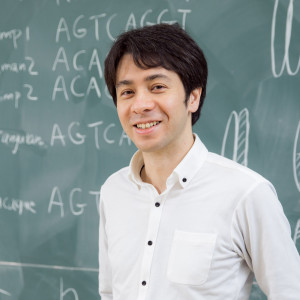Volume 265
Back to Newsletter List
Press Release
Deciphering the Buckwheat Genome - High-Precision Genome Sequence Illuminates the Past and Future of Buckwheat -
2023-08-23
As the world population is expected to reach 9.7 billion by 2050, the dependence on the three major cereals - rice, wheat, and corn - is becoming a concern. In response, interest in "orphan crops" is increasing, which have high value as food but whose research has lagged, leaving their potential untapped. Determining the genomes of orphan crops using next-generation sequencing technology is expected to promote their efficient breeding and contribute to the achievement of SDGs such as eradicating hunger and improving nutrition.
An international collaborative research group (including Jeffrey Fawcett, iTHEMS) deciphered the genome sequence of buckwheat, an orphan crop cultivated in Eurasia that is used for making soba noodles in Japan, at the chromosomal level with high precision, revealing the evolution of the buckwheat genome and the origin of cultivated buckwheat. Moreover, they modified the predicted genes using methods that do not rely on genome editing technology. As a result, they successfully developed a glutinous buckwheat and a new self-pollinating buckwheat that did not previously exist. The breeding methods used in this study are expected to contribute to the improvement of a wide variety of orphan crops in which genome editing technology cannot be used.
For more information, please see the Kyoto University press release article at the related links.
Reference
- Jeffrey A. Fawcett, Ryoma Takeshima, Shinji Kikuchi, Euki Yazaki, Tomoyuki Katsube-Tanaka, Yumei Dong, Meifang Li, Harriet V. Hunt, Martin K. Jones, Diane L. Lister, Takanori Ohsako, Eri Ogiso-Tanaka, Kenichiro Fujii, Takashi Hara, Katsuhiro Matsui, Nobuyuki Mizuno, Kazusa Nishimura, Tetsuya Nakazaki, Hiroki Saito, Naoko Takeuchi, Mariko Ueno, Daiki Matsumoto, Miyu Norizuki, Kenta Shirasawa, Chengyun Li, Hideki Hirakawa, Tatsuya Ota, Yasuo Yasui, Genome sequencing reveals the genetic architecture of heterostyly and domestication history of common buckwheat, Nature Plants 9, 1236–125 (2023), doi: 10.1038/s41477-023-01474-1
- Press release: Kyoto University (in Japanese)
- Press release: RIKEN (in Japanese)
- Complete Genome Sequencing of Buckwheat Leads to the Development of Glutinous Dough: Kyoto University | Nikkei (in Japanese)
- 100% Soba Noodles Can Be Made Easily? World's First Breeding of Glutinous Soba with Smooth Texture and Good Fragrance: Asahi Shimbun Digital (in Japanese)
- 100% Soba Noodles Can Be Made Easily? Kyoto University and Others Sequence the Genome and Develop "Glutinous" Soba That Doesn't Easily Break for the First Time | Asahi Shimbun Digital (in Japanese)
Upcoming Events
Seminar
iTHEMS Seminar
MNISQ: A Large-Scale Quantum Circuit Dataset for Machine Learning on/for Quantum Computers in the NISQ era
August 29 (Tue) 14:00 - 15:30, 2023
Leonardo Placidi (Ph.D. Student, Graduate School of Engineering Science, Osaka University)
We introduce the first large-scale dataset, MNISQ, for both the Quantum and the Classical Machine Learning community during the Noisy Intermediate-Scale Quantum era. MNISQ consists of 4,950,000 data points organized in 9 subdatasets. Building our dataset from the quantum encoding of classical information (e.g., MNIST dataset), we deliver a dataset in a dual form: in quantum form, as circuits, and in classical form, as quantum circuit descriptions (quantum programming language, QASM). In fact, also Machine Learning research related to quantum computers undertakes a dual challenge: enhancing machine learning by exploiting the power of quantum computers, while also leveraging state-of-the-art classical machine learning methodologies to help the advancement of quantum computing. Therefore, we perform circuit classification on our dataset, tackling the task with both quantum and classical models. In the quantum endeavor, we test our circuit dataset with Quantum Kernel methods, and we show excellent results with up to 97% accuracy. In the classical world, the underlying quantum mechanical structures within the quantum circuit data are not trivial. Nevertheless, we test our dataset on three classical models: Structured State Space sequence model (S4), Transformer, and LSTM. In particular, the S4 model applied on the tokenized QASM sequences reaches an impressive 77% accuracy. These findings illustrate that quantum circuit-related datasets are likely to be quantum advantageous, but also that state-of-the-art machine learning methodologies can competently classify and recognize quantum circuits. We finally entrust the quantum and classical machine learning community.
Reference
- Leonardo Placidi, Ryuichiro Hataya, Toshio Mori, Koki Aoyama, Hayata Morisaki, Kosuke Mitarai, Keisuke Fujii, MNISQ: A Large-Scale Quantum Circuit Dataset for Machine Learning on/for Quantum Computers in the NISQ era, (2023), arXiv: 2306.16627
Venue: #345, 3F, Main Research Building, RIKEN Wako Campus / via Zoom
Event Official Language: English
Seminar
iTHEMS Seminar
The Cosmic Gravitational Microwave Background
September 6 (Wed) 15:00 - 16:30, 2023
Jan Schuette-Engel (Postdoctoral Researcher, RIKEN Interdisciplinary Theoretical and Mathematical Sciences Program (iTHEMS))
The thermal plasma in the early universe produced a guaranteed stochastic gravitational wave (GW) background, which peaks today in the microwave regime and was dubbed the cosmic gravitational microwave background (CGMB). I show that the CGMB spectrum encodes fundamental information about particle physics and gravity at ultra high energies. In particular, one can determine from the CGMB spectrum the maximum temperature of the universe and the effective degrees of freedom at the maximum temperature. I also discuss briefly how quantum gravity effects arise in the CGMB spectrum as corrections to the leading order result.
Venue: Hybrid Format (3F #359 and Zoom), Main Research Building, RIKEN Wako Campus
Event Official Language: English
Seminar
ABBL-iTHEMS Joint Astro Seminar
Collective Plasma Effects in Relativistic Radiation-Mediated Blast Waves
September 8 (Fri) 14:00 - 15:15, 2023
Arno Vanthieghem (Princeton-NINS Postdoctoral Research Fellow, Department of Astrophysical Sciences, Princeton University, USA)
Relativistic radiation-mediated shocks (RRMS) dictate the early emission in numerous transient sources such as supernovae, low luminosity gamma-ray bursts, binary neutron star mergers, and tidal disruption events. These shock waves are mediated by Compton scattering and copious electron-positron pair creation. It has been pointed out that a high pair multiplicity inside the shock transition leads to a lepton-baryon velocity separation, prone to plasma instabilities. The interaction of the different species with this radiation-mediated microturbulence can lead to coupling and heating that is unaccounted for by current single-fluid models. Here, we present a theoretical analysis of the hierarchy of plasma microinstabilities growing in an electron-ion plasma loaded with pairs and subject to a radiation force. Our results are validated by particle-in-cell simulations that probe the nonlinear regime of the instabilities and the lepton-baryon coupling in the microturbulent electromagnetic field. Based on this analysis, we derive a reduced transport equation for the particles that demonstrates anomalous coupling of the species and heating in a Joule-like process by the joined contributions of the decelerating turbulence, radiation force, and electrostatic field. We will then discuss the effect of finite magnetization on the general dynamics and recent efforts toward a more self-consistent description of the coupling. In general, our results suggest that radiation-mediated microturbulence could have important consequences for the radiative signatures of RRMS.
Venue: via Zoom
Event Official Language: English
Seminar
iTHEMS Theoretical Physics Seminar
Induced gravitational waves from inflaton oscillons
September 22 (Fri) 14:00 - 15:30, 2023
Kaloian Dimitrov Lozanov (Project Researcher, Kavli Institute for the Physics and Mathematics of the Universe (Kavli IPMU), The University of Tokyo)
We present a new way to study cosmic inflation with gravitational waves. The gravitational signal is generated thanks to nonlinear structures in the inflaton field, called oscillons. This novel probe allows us to test models of inflation which are challenging to test with CMB experiments.
Venue: Hybrid Format (3F #359 and Zoom), Main Research Building, RIKEN Wako Campus
Event Official Language: English
Seminar
ABBL-iTHEMS Joint Astro Seminar
Progenitors and Explosion Properties of Supernova Remnants Hosting Central Compact Objects
October 6 (Fri) 10:00 - 11:30, 2023
Chelsea Braun (Ph.D. Student, Department of Physics and Astronomy, University of Manitoba, Canada)
Presented is a systematic, global study of Galactic supernova remnants (SNRs) hosting Central Compact Objects (CCOs) aimed at addressing their explosion properties and supernova progenitors. With the Chandra and XMM-Newton telescopes, a spatially resolved X-ray spectroscopy study is performed on seven SNRs that show evidence of shock-heated ejecta. Using an algorithm, we segmented each SNR in the sample into regions of similar surface brightness. These regions were fit with one- or two-component plasma shock model(s) in order to separate the forward-shocked interstellar medium from the reverse shock-heated ejecta which peak in the X-ray bands for elements including O, Ne, Mg, Si, S, Ar, Ca, and Fe. We subsequently derived the explosion properties for each SNR in the sample and found overall low explosion energies (<10^51 erg). To address their progenitor mass, we compare the measured abundances from our spectroscopic modelling to five of the most widely used explosion models and a relatively new electron-capture supernova model. Additionally, we explore degeneracy in the explosion energy and its effects on the progenitor mass estimates. However, no explosion models match all of the measured ejecta abundances for any of the SNRs in our sample. Therefore, we present our best progenitor mass estimates and find overall low progenitor masses (<=25 solar masses) and we highlight the discrepancies between the observed data and the theoretical explosion models.
Venue: via Zoom
Event Official Language: English
Seminar
ABBL-iTHEMS Joint Astro Seminar
Early Formation of Dark Matter Halos
November 24 (Fri) 14:00 - 15:15, 2023
Derek Beattie Inman (Research Scientist, RIKEN Interdisciplinary Theoretical and Mathematical Sciences Program (iTHEMS))
Cosmological observations have led to an extremely precise understanding of the large-scale structure of the Universe. A common assumption is to extrapolate large-scale properties to smaller scales; however, whether this is correct or not is unknown and many well-motivated early Universe scenarios predict substantially different structure formation histories. In this seminar I will discuss two scenarios where nonlinear structures form much earlier than is typically assumed. In the first case, the initial fluctuations are enhanced on small scales leading to either primordial black holes clusters or WIMP minihalos right after matter-radiation equality. In the second, I will show that an additional attractive dark force leads to structure formation even in the radiation dominated Universe. I will furthermore discuss possible observations of such early structure formation including changes to the cosmic microwave background, dark matter annihilation, and when the first galaxies form.
Venue: Seminar Room #359, 3F Main Research Building, RIKEN / via Zoom
Event Official Language: English
Paper of the Week
Week 4, August 2023
2023-08-24
Title: Universality in quasinormal modes of neutron stars with quark-hadron crossover
Author: Hajime Sotani, Toru Kojo
arXiv: http://arxiv.org/abs/2308.11494v1
Title: Kramers-Krönig approach to the electric permittivity of the vacuum in a strong constant electric field
Author: Hidetoshi Taya, Charlie Ironside
arXiv: http://arxiv.org/abs/2308.11248v1
Title: de Sitter space is sometimes not empty
Author: Vijay Balasubramanian, Yasunori Nomura, Tomonori Ugajin
arXiv: http://arxiv.org/abs/2308.09748v1
Title: Plant GARDEN: a portal website for cross-searching between different types of genomic and genetic resources in a wide variety of plant species
Author: Hisako Ichihara, Manabu Yamada, Mitsuyo Kohara, Hideki Hirakawa, Andrea Ghelfi, Takuro Tamura, Akihiro Nakaya, Yasukazu Nakamura, Sachiko Shirasawa, Samatchaya Yamashita, Yosuke Toda, Daijiro Harada, Tsunakazu Fujishiro, Akiko Komaki, Jeffrey A. Fawcett, Eiji Sugihara, Satoshi Tabata, Sachiko N. Isobe
Journal Reference: BMC Plant Biology 23, 391 (2023)
doi: https://doi.org/10.1186/s12870-023-04392-8
Title: Genome sequencing reveals the genetic architecture of heterostyly and domestication history of common buckwheat
Author: Jeffrey A. Fawcett, Ryoma Takeshima, Shinji Kikuchi, Euki Yazaki, Tomoyuki Katsube-Tanaka, Yumei Dong, Meifang Li, Harriet V. Hunt, Martin K. Jones, Diane L. Lister, Takanori Ohsako, Eri Ogiso-Tanaka, Kenichiro Fujii, Takashi Hara, Katsuhiro Matsui, Nobuyuki Mizuno, Kazusa Nishimura, Tetsuya Nakazaki, Hiroki Saito, Naoko Takeuchi, Mariko Ueno, Daiki Matsumoto, Miyu Norizuki, Kenta Shirasawa, Chengyun Li, Hideki Hirakawa, Tatsuya Ota, Yasuo Yasui
Journal Reference: Nature Plants volume 9, pages 1236–1251 (2023)
doi: https://doi.org/10.1038/s41477-023-01474-1
If you would like to cancel your subscription or change your email address,
please let us know via our contact form.
Copyright © iTHEMS, RIKEN. All rights reserved.




